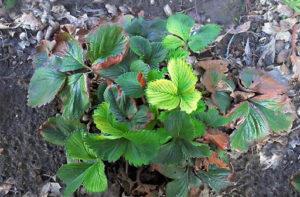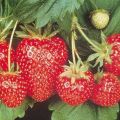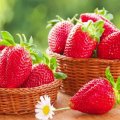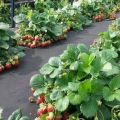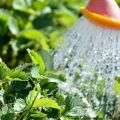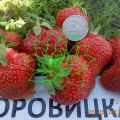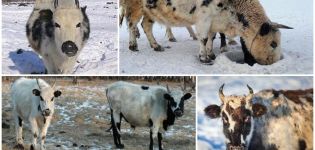When and how to properly mulch strawberries, the better
Many gardeners are involved in mulching strawberries, as this is the most reliable method of protecting berries from pests, diseases and frost. Before you start mulching, you need to familiarize yourself with the features of this process.
What is mulch for when growing strawberries
Mulching is called covering the soil near strawberry bushes with organic materials, cardboard or plastic wrap. The covering material prevents premature evaporation of liquid from the upper layers of the soil, and also significantly reduces the amount of watering in spring and summer. With the help of mulch, moisture in the soil remains for a long time, which improves the fruiting of strawberries.
Also, some gardeners cover the soil with a mulch layer to slow down the growth of weeds. Therefore, people who mulch strawberry seedlings rarely do weeding. In addition, the covering layer prevents heat from leaving the soil. This prevents the soil and strawberry roots from freezing.
Experienced gardeners advise using mulch to protect the plant from gray mold.
After mulching the soil, strawberry berries will not come into contact with wet soil, and therefore the likelihood that they will begin to rot is extremely small.
Advantages and disadvantages
Coating the soil surface with mulch has benefits and harms, which it is recommended to familiarize yourself with in advance. The main advantages of the mulch layer are:
- improving the fruiting of strawberry seedlings when using organic components;
- reduction of soil loosening and watering;
- protection of ripe berries from attacks of some insects and premature decay;
- improving productivity due to saturation of the soil with micronutrients.
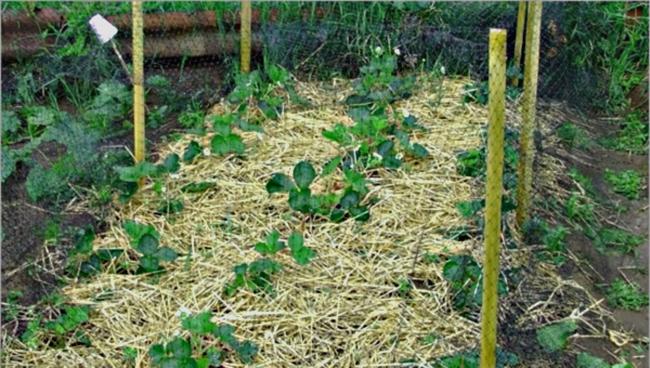
The disadvantages include the following:
- development of fungal diseases in the mulch layer;
- the appearance of a bear and slugs under the mulch.
When to mulch a plant
It is recommended to determine in advance the timing of the procedure in order to mulch the soil in time. Experienced gardeners recommend doing this at least twice a year. First, mulch is used in late spring, when young fruits are formed on strawberry bushes. The procedure is carried out to protect the peduncles from contact with the ground. The spring mulch is harvested in August when the entire crop has been harvested.
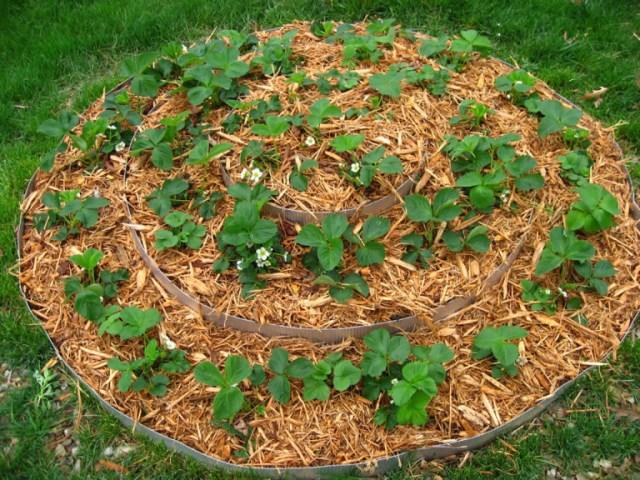
The second procedure is carried out in autumn - in October or November. If you do not use mulch in the fall, the bushes will freeze at the first frost.
How and how to mulch strawberries
When mulching strawberries, they use various materials that you need to familiarize yourself with in advance.
Organic materials
Most often, organic matter is used as mulch, which saturates the soil with nutrients and protects the seedlings from the cold.
Straw
Some gardeners use straw bedding to improve yields. It is recommended to use broken straw, as dry straw takes a lot of nitrogen from the soil.
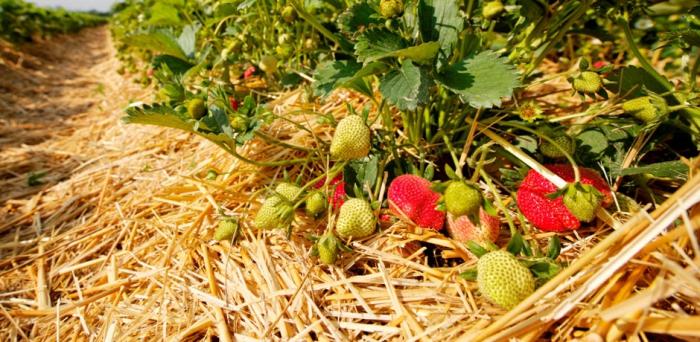
To properly fill strawberries with straw, perform the following sequence of actions:
- Shaking up the material. It is necessary to shake all the straw beforehand to clear it of pests and weed seeds.
- Site preparation. The area where strawberries are grown is weeded and cleaned of grass.
- Styling. All straw is evenly distributed around the bushes. In this case, the height of the straw litter should be 1-2 centimeters.
Needles
Many people prefer to sprinkle the beds with needles, since it contains many bactericidal components and phytoncides. The coniferous coating protects the berries from most pests and infectious diseases. Also, the substances that make up the needles have a positive effect on the taste of ripe berries.

To create a mulching layer, dried, yellow coniferous branches are used. They are laid out on the site in a layer 3-4 centimeters high. The needles are harvested in spring, during the first weeding of strawberries.
Hay, fresh grass and green manure
There are other organic materials that are often used for mulching:
- Hay. An ideal material to cover up a plot. With the help of dried, cut grass, oxidation and overheating of the soil is prevented. The layer of hay should not be higher than 4 centimeters.
- Grass. Mulching strawberry bushes with fresh grass is carried out in the same way as when using straw. The covering layer should be 5-6 centimeters high.
- Siderata. Some people make a layer of mulch from the grass cut from the garden. It is dried and laid out on the strawberry beds.
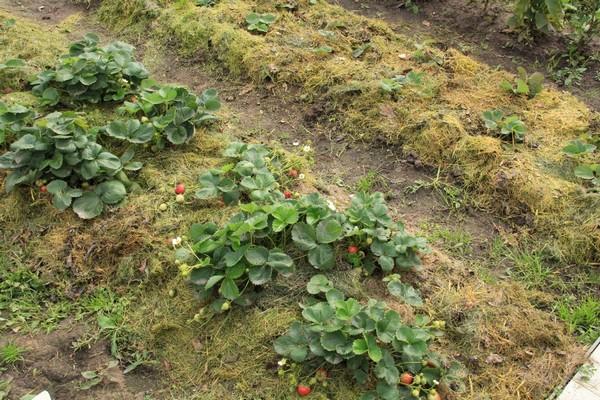
Tree bark
Another common mulching material that is popular with gardeners is bark. Most often they use pine bark, which reliably protects the soil from overheating and freezing. It contains tanning components that prevent soil oxidation.
Pine bark is considered the most durable mulch, as it lasts 5-6 years. The bark mulch layer should be 7-9 centimeters thick.
Sawdust
To prevent the appearance of pests, sawdust is used, the rough surface of which protects the seedlings from snails and slugs. This material takes a long time to decompose, and therefore such a mulching layer lasts for at least three years. This woody material strongly absorbs moisture, and therefore, when using it, you will have to water the berries more often.
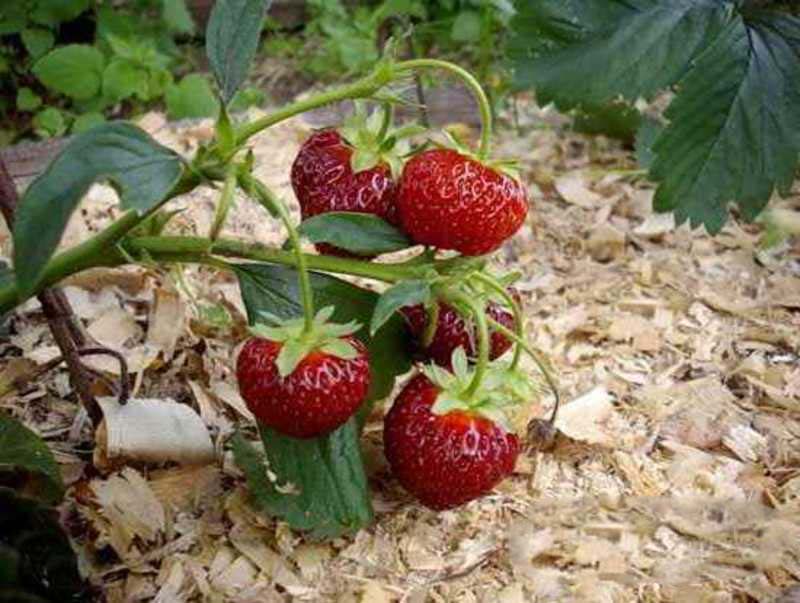
Before pouring out the sawdust, the overlapping surface of the bed is covered with newsprint. A layer of sawdust 4-5 centimeters thick is poured on top.
Inorganic materials
There are several inorganic materials that many use during mulching.
Cardboard
One of the most affordable covering materials is cardboard. Cardboard sheets are laid with an overlap between the seedlings so that there are holes for watering around the bushes. The joints of the cardboard should be fixed with heavy objects so that they are not ripped off by gusts of wind.

After laying, organic dressings are placed under the cardboard sheets to improve fruiting and ripening of berries.
Spunbond
It is a high quality material that is able to maintain soil moisture and temperature. Spunbond also protects seedlings from heat and frost. Such material is used before planting seedlings.Spunbond is carefully spread over the surface of the beds, after which holes are made on it for watering and fertilizing. Then the edges of the material are fixed with special pins, which are driven into the soil.
The main advantages of spunbond include:
- protection against mechanical damage;
- long service life, which is 3-4 years;
- resistance to decay and high humidity.
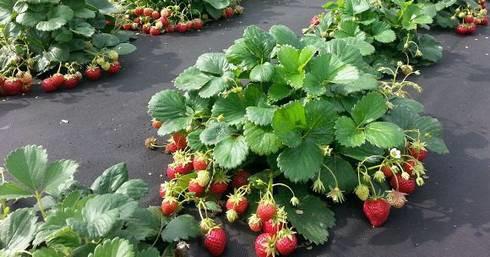
Film
For mulching strawberries, a black film is often used, which does not deteriorate for three years. It is ideal for protecting plants from frost and disease. In regions with hot summers, it is advised to use a white film that will retain moisture and repel the sun's rays. When using film material, you will have to organize micro-drip irrigation in advance on the beds.
Recommendations for beginners
There are several recommendations that you should read before mulching:
- before spring mulching, the soil is loosened so that it warms up better;
- to create a straw bedding, it is contraindicated to use wheat straw, as it is strongly caked;
- after winter, all sawdust is raked from the rows to lay out a new layer;
- it is better to replace rotted and too compacted straw with fresh one;
- before mulching, the soil is fertilized with nitrogen and mineral fertilizers.
Conclusion
People who are going to grow strawberries will have to mulch. Before that, you should familiarize yourself with the timing and features of creating a protective layer.
